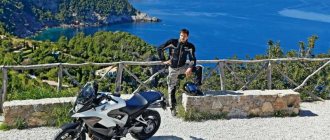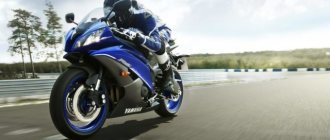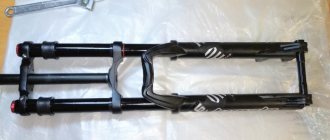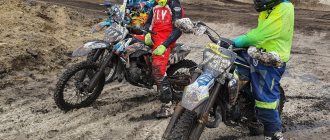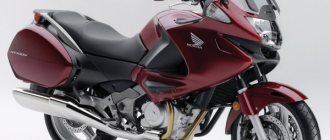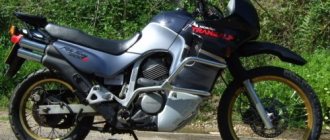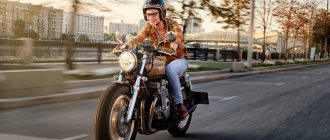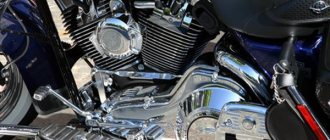CROSSRUNNER – overall impression of the motorcycle
Honda VFR800X is a heavy motorcycle. At 242kg it's one of the heaviest bikes I've ever handled. And the first thing that comes to my mind is the ideal adaptation of the motorcycle to the conditions prevailing on our Russian roads. This is mainly due to the fact that the suspension is perfectly adapted to bumps, both during normal driving and at a faster gallop. This motorcycle handles well in the city, but this is not its element. It will perform better on the road. It will also plow loose soil properly, thanks to well-functioning systems. And since I started with conclusions, let's move on to the rationale
Honda VFR800X Crossrunner
HONDA VFR800X – engine
First a word about the propulsion system, because a lot depends on it, but it has a feature that for many will knock this bike off, but for others it will be a huge advantage. I mean V4-VTEC. VTECs are either loved or hated. A decision that has as many supporters as opponents. For me it was the first motorcycle with a VTEC engine and... I loved it! I expected impressive lift-off of the bike, wheel slippage and other unforeseen excesses. But it soon turned out that this devil was not so terrible.
You should also note here that I would like to get the Type R because that's the decision I get. This dual-zone speed range is an interesting solution. Less power for exploring around town and sporty performance for fun in the spin area, where there is still a hint during a session on the trails.
Honda VFR800X Crossrunner
This solution also worked in a motorcycle. Of course, you can feel it when a sharper shaft enters. The difference is noticeable, you feel a jerk, the motorcycle begins to tear when you lose the muzzle. At the same time, this can be heard on the standard exhaust. The pleasant noise turns into a roar (which can be heard a little here). But the transition is not so abrupt as to throw the driver out of the saddle. Of course, you have to be careful because at lower speeds, on slippery asphalt, you can now wobble. To do this, the engine has so much power that the motorcycle brakes the wheel. If VTEC is turned on during such a flight... it may vary
Overall, the engine performs well and has enough power to move those 242 kilograms with pleasant acceleration. However, there are three things to remember. First of all: at lower speeds, up to 3000 rpm, it can “stutter”. In a gear that is too high, the bike will jerk. Second: engine braking at low speeds is practically absent. If we use gas in the VTEC range, we noticeably lose speed. However, at low speeds there is no strong effect, and you need to brake. And thirdly: the engine has an appetite for fuel.
Honda VFR800X Crossrunner
Honda VFR800X Crossrunner: test drive from Avto.Mail.ru experts
Sneakers have long ceased to be just sports shoes. Nowadays these are more shoes for every day, light, comfortable, practical. This kind of urban style - winding kilometers around the city, running about your many errands - is just right. This motorcycle is very reminiscent of this particular one, which used to be a sports bike, but now it’s just a city shoe. When it first appeared, in 2011, it caused a lot of buzz. It was with him that Honda began its recent history with motorcycles that do not fall under more than one well-known and generally accepted class. There was so much talk! This is a crossover, some said. With such a meager ground clearance and road tires? - others retorted. In general, the motorcycle turned out to be ambiguous. Let us also remember that at about the same time, all progressive motorcycle humanity was eagerly awaiting the release of a “big enduro” from Honda, the reincarnation of Africa Twin , even then everyone knew that it would be a liter or two hundred with a V4 engine. And suddenly, bang... or rather, zilch. And instead of the long-awaited “Africa”, the world was shown, to put it mildly, an under-enduro, grown from... a VFR800 sports tourer, discontinued a year earlier. There was no limit to human indignation. The other part of society, a very small one, chuckled at the unfortunate Hinduists and quickly acquired a new product.
Now, after some time has passed, you can look at the motorcycle with a calmer look. Not biased, with an already formed opinion. So, let me remind you that a “crossrunner” is, as the Honda people themselves position it, a crossover. Let me note that the term “crossover” itself is a rather loose concept. It seems that some V-Strom with its alloy wheels, asphalt wheel size and abundance of plastic fits well into this category, but even it is much more “endurable” than our today’s “patient”. Let's define the VFR800X Crossrunner as a motorcycle that stands on the border of crossovers and road bikes. From the off-road tribe there is really only a slight hint in the lines of the facings, and an atavistic “beak” above the front fender.
When developing the motorcycle, the well-known, tested and brought to logical perfection sports-touring VFR800, which, in turn, has a pedigree from quite purebred “athletes” of the 80s, was taken as a basis. The “Runner” inherited from its ancestor the engine, frame, proprietary cantilever swingarm of the rear wheel and front suspension. The rest has been heavily reworked. Although the above is practically the “whole motorcycle”, it turned out that the hitch is also not at all small. But more on that below. First things first. The Vyferov engine, the famous 90-degree four-cylinder, was slightly retuned: the maximum power was reduced from 108 hp. at 10500 rpm up to 102 hp. at 10,000 rpm, thereby smoothing the characteristic and slightly increasing torque throughout the entire rev range. I think that most users will not even notice such a difference, but the fact remains.
The second change is also purely nominal and will most likely be unnoticeable for the average user. The fork angle was slightly changed - from 25.30 degrees to 25.45. Fifteen hundredths seems like nonsense. However, the bike became noticeably calmer and stopped “breaking” in turns. Such “pennies” made the new device smoother, calmer and more friendly - and this is what the average motorcyclist needs, who wants to calmly and without fanaticism (albeit at a very brisk pace) carry his car on business and while idle riding. This is where the changes to the old design that affect driving performance have generally ended.
And then the most interesting thing began: innovations that do not affect the “speed” so much, but are very clearly visible to the naked eye. Firstly, the motorcycle was fitted with a new handlebar. It’s not good for a city dweller to buzz his sirloin up in the aisles. It’s convenient on the track with clip-ons or on the highway, slightly beyond 200 km/h, but in traffic jams your back gets stiff, your arms get tired, and in general, as you know, a goat doesn’t really need an accordion. The “crossrunner” has a high “touring” steering wheel, a la “Golda”, hidden in a plastic casing. The footpegs, by the way, remained in their places, in a sport-tourist style, but the seat became more “humane”, although in the “Vyfer” it was also quite comfortable - a tourist after all. Naturally, the tank, side trims, and tail were remade. To create a “crossover” ambiance, a small beak was attached above the front wing. In general, the landing turned out... incomprehensible. The legs are sporty, the arms are classic, the back is roadster-like with a hint of touring. Surprisingly, this whole cocktail created a completely comfortable position for the pilot. A straight back, relaxed arms, a rather narrow (by the standards of enduro and even roadster stick handlebars) grip, a comfortable, rather wide, but prone to hanging seat and a fairly collected, sporty, but without fanaticism, leg position. That is, it seems like the top of you sits on a classic, and the bottom on a sports-tourist. While you are quietly rolling, nothing annoys you, no parts of your body become numb: “I sit high, I look far away,” the car mirrors pass under the steering wheel handles. But once you see a “tasty” turn ahead, it doesn’t cost anything to hang down and properly, with a quickdraw and scraping the pegs on the asphalt, go through a beautiful arc. We remember that the entire chassis is quite from the “sports family”!
The motorcycle turned out to be an excellent companion in the metropolis. This very “atypical” fit turned out to be very comfortable and practical. A moderately wide steering wheel and a slightly “blunt” chassis, relative to VFR, make moving in heavy traffic very easy and pleasant. No nervousness or kicking, but at the same time absolute obedience and precision in executing the pilot’s commands. “Licking” the narrow corridors left for motorcyclists by cars stuck in traffic jams is a pleasure. Of course, the full road clearance, limited by the exhaust system pipes of the front cylinders running under the “belly”, does not allow you to force all the curbs and potholes without looking, and the suspension most likely won’t thank you for such exercises (I haven’t tested the strength) , but standing up to get past the speed bump is easy. The high steering wheel helps. When standing on the footrests, you don't have to take a question mark pose. Back straight, arms unloaded, maneuver - I don’t want to. In general, the city is his element.
I can’t help but dwell on the engine. Still, the inline four, although productive, powerful, and generally the choice of all trendy sportbikes, is a rather boring thing. It doesn’t work at the bottom, just go to the top. In general, flat, boring and ordinary. V-twins, in this sense, are somehow more alive, real, or something. You can feel some kind of living pulsation and character in them... Another thing is that two-cylinder Vashki have absolutely no tops, and “live pulsations” are often very annoying, especially “at the tops”. But if you cross a boring but torquey inline-four with a V-twin, you get either an inline-two or a V4. Mixing races has always produced beautiful children. So it is here. Both the in-line “deuce” and, as in our case, the V-shaped “four” are excellent children who have taken the best from their parents. Juicy traction from the very bottom and, at the same time, excellent “twist” with the power it relies on at the top. At the same time, there is also a middle! Now let’s remember the most “delicious” VFR engine cartoon! Of course, this is a VTEC variable valve timing system! The first half of the tachometer, only two valves work in each valve. This scheme helps to increase traction “at the bottom”, but is not able to “digest” a lot of fuel “at the top”. So, let's combine. Basically, the automation connects two additional valves in each cylinder. The filling capacity of the mixture, and hence the power, increases sharply. The effect is achieved: traction “at the bottom” and power “at the top”.
In practice it all looks like this. We begin to accelerate vigorously. Towards the middle of the tachometer, the engine begins to noticeably turn sour, but suddenly, on the oh, the exhaust sound changes sharply from “zhzhzhzhzh” to “ffaaaaaaaaaaaaaaaaaaaaaaaaaaaaaaaaaaaaaaaaaaaaaaaaaaaaaaaaaaaaaaaaaaaaaaaaaaaaaaaaaaaaaaaaaaaaaaaaaaaaaaaaaaaaaaaaaaaaaaaaaaaaaaaaaaaaaaaaaaaaaaaa very traffic light racers.
I would like to note that the effect of the “high-speed express” that caught up with you sitting on the rails is long gone. The system works very delicately. I have heard many times that the system is dangerous, they say, you are entering a turn, and then bang, VTEC covers you, a kick, the wheel falls off, and you fall. This is not and cannot be. At low throttle the system is not switched on at all. At medium - noticeable, to a greater extent, by the change in the exhaust sound - the engine begins to “sing”. And only if you accelerate into a “full hole”, you feel that very “kick in the ass”, and even then, it is not so much sharp as pleasant. And so the “almost a liter” drives quite cheerfully, so there’s also such a bonus! In general, an incredibly tasty “candy” for those who like to unscrew the handle! By the way, in a quiet driving mode, during the day, in heavy traffic, when there is no need to “tear and throw,” you don’t even remember about VTEC: “almost a liter” allows you to drive very cheerfully in the “up to 6000 rpm” range. All the same, you will leave the traffic light much earlier than everyone else. But what about weekends and vacations? We are pragmatic people, a moto should not only be able to live in the city? With this, the “crossrunner” is completely fine. The blood is sports-tourist. The device has completely inherited its long-range qualities from its “dad”, without losing a single drop. On a long-distance trip he feels just as confident and at ease. The engine is behind the scenes. Overtaking slow trucks and “fast” guys in cars is easy for him. This is what that “VTEK” is for! I dropped a gear or two down, opened a hole, and the “magic kick” already carried you far ahead of the overtaken.
The standard glass, although not tall, copes with its duties quite well, although for me, with my 188 centimeters, the flow is reflected directly into the visor. For people like me, and for those who are just dudes, the tuning arsenal also includes a high windshield. Even sleepers like me will be quite comfortable with it, even if we don’t cover the visor. Among the other “long-range” bonuses, one cannot ignore a set of panniers, the total volume of which is comparable to a medium-sized suitcase, deflectors that cut off the air flow from the pilot’s legs and, of course, heated handles. Where would a “last chance” vacation in October be without them? In general, with some funds, a city dweller can easily turn into a completely skillful and comfortable “kilometer eater.” This, of course, is not a “thrush” or a “hayabusa” falcon, but it will resemble an agile and speedy swift.
Still, the analogy with sneakers haunts me. Even if they are khaki, with a bunch of mesh and a “toothy” tread on the outsole, they are still sneakers. It’s better not to climb mountains in them, and they’ll get wet if it rains. But in the city, and even in the open air (in good weather, of course), you won’t find better shoes. Whether walking around the world, walking, running, or skipping.
So is our “crossrunner”. If you want to go to work, if you want to go to a picnic, or if you want to go to the sea. Just don’t buy into the color and design (in our case, the enduring “beak” and the “cross” prefix in the name). Still, he is a runner. But comfortable, cozy and amazingly homely. Like your favorite sneakers that you don’t want to throw away, even when all that’s left of them is “one continuous ventilation” and thousands of kilometers of memories.
Source: Auto.Mail.ru
Go to Honda VFR800X
- Read review of Honda VFR800X
Check out the test drives:
- Honda VFR800X Crossrunner: test drive from Za Rulem magazine
- Honda VFR800X Crossrunner: test drive from Motorreview magazine
- Honda VFR800X Crossrunner: test drive from Top Gear
HONDA VFR – combustion
Although I always say that a bike burns everything that goes into it, I don't pay attention to the burn because the fun starts where the economy ends... especially at high horsepower, this bike surprised me. After driving 200 km, I didn't have enough time, I was in a hurry, but I had to slow down because the spare light came on. At that time I started looking more closely at flash combustion and it turned out that:
- at 140 km/h the motorcycle consumes 5.5 l/100 km
- at 160 km/h it’s already 7l/100km
- and at 180km/h the wire in the tank pulls 9l/100km.
On the final day of testing, during refueling, the average combustion achieved on the combined cycle over a distance of 855 km was 7.9 l/100 km. You can say that it burns fuel similar to the Honda Fireblade. But it's also a lot of fun to drive, so once the fuel is burned, it's too late to cry.
In theory this could be achieved at 5.5L/100km and I am convinced that this needs to be done. I failed... it's difficult
Honda VFR800X Crossrunner
Honda VFR 800X Crossrunner: characteristics, reviews, history
The technical characteristics of the Honda VFR 800X Crossrunner motorcycle are classic for its type (tourist enduro).
So, first things first. The Honda Crossrunner motorcycle is equipped with a powerful 4-stroke V-twin engine. Depending on the year of manufacture, engine power varies from 102 to 106 hp. The front fork is telescopic, its travel is 10.8 cm.
Driving safety is ensured by the presence of high-quality brakes (2 discs - front and 1 + ABS at the rear). The frame is aluminum, durable but lightweight.
The weight of the bike is about 238 kg (equipped). Fuel supply type - electronic injection. The motorcycle is equipped with electronic ignition. A chain is used as a drive. And the gearbox is 6-speed.
The VFR 800X Crossrunner is not a sports bike, and therefore is not focused on ultra-high-speed modes. Moreover, its maximum speed is 200 km per hour.
Fuel consumption
Despite its impressive weight, the VFR 800 X is considered economical. It consumes about 6.1 liters per 100 km. But the tank is capacious, its volume is 21 liters + reserve. This is enough to cover about 330-350 km without refueling. The ride of the motorcycle is soft and smooth. The seats are comfortable, and therefore increase comfort when driving and traveling long distances.
It behaves well off-road, with only one drawback - increased fuel consumption. It’s also not worth getting the maximum out of the bike. But driving in cruising mode (110-130 km) is optimal and safe, with minimal consumption of resources.
Model range and history of the Honda VFR 800X model
The VFR 800 crossrunner is available in two versions:
- From 2011 to 2014, the Honda VFR800X Crossrunner was produced. This was a classic modification and the first appearance on the market.
- In 2015, the model was restyled. The updated version has become more comfortable for the driver. With significant design changes, the grips have also been replaced (now heated), turn signals with automatic shutoff, the subframe and engine have been updated.
In general, although the principle of operation remained the same, the drivers liked the new, more comfortable conditions. For example, smooth driving was ensured by an increase in engine power (up to 106 hp) and fork travel (14.5 and 14.8 cm).
Comparison of Honda VFR 800X with analogues and competitors
The only competitor in the class for the Honda VFR 800X motorcycle was and is the Kawasaki Versys 1000. It is more powerful (120 hp), and also a little heavier and faster.
Although the motorcycles are similar in appearance, this is only at first glance. The Kawasaki accelerates to 100 km/h in just 3.5 seconds. And its maximum speed is 226 km (25 km more than the Honda vfr800x crossrunner). The Versys 1000 is slightly longer and more economical in terms of consumption (consumes about 5.2 liters per 100 km).
There are no decisive differences between the compared models as such. However, fans of both models have something to gossip about and present their own arguments.
Advantages and disadvantages
VFR800X – quickly gained success in the market. Chain drive and a well-designed windshield (which reliably protects against wind flow) are among the many advantages of the motorcycle. Many people note the peculiarity of these bikes in such details as:
- combined brake system;
- hydraulic clutch;
- presence of a VTEC system.
In other words, the fundamentals for a sports tourist are more than fine. In terms of maintenance, Honda is unpretentious. It is recommended to have your equipment serviced by authorized representatives.
Consumables are available in terms of cost, and spare parts can be ordered (or replaced immediately at specialized service stations). There are essentially no visible disadvantages. Is it possible to consider the low driving speed as a disadvantage? But, given the type of bike, this figure is normal. However, some owners have complaints about the rigidity of the seat and its position in relation to the steering wheel.
Reviews from Honda VFR 800X owners and operating experience
Vladislav, 30 years old: “It depends on you, but I didn’t really like the VFR800X Crossrunner. As a motive, I’ll go step by step through all the hot spots. Let me start with the fact that I didn’t understand what type to classify him as. It looks like a road worker, but it’s all plastic, supposedly safe. At 100-120 km per hour, it brakes clearly, there’s no problem here. But after 140, he throws it like crazy (wiggles). Scary in other words. But if you don’t put pressure on it, it’s quite suitable for city driving.”
Andrey, 37 years old: “I would like to note the performance of the engine. In general, it sings, but this is only up to 7000 rpm. Further - too shrill and noisy. I don’t really like it, because it feels like something is going to happen!”
Tuning and repair
Honda vfr800x crossrunner can be additionally equipped with panniers (top and side). Regarding repairs, there is no clear opinion in terms of what breaks down most often (motorcycles have not been on the market for very long, and they have no obvious features).
The owners' recommendation is not to “force” the engine at high speeds (over 150 km), monitor consumables and the quality of the fuel used.
HONDA VFR800X – suspension
Another plus is the suspension of this motorcycle. We have stepless preload adjustment and 10 degrees of front cupid relief, as well as rebound damping adjustment and 35-degree preload adjustment. I rode on an intermediate setup and the bike handled the potholes nicely, both at leisure speed and during fast acceleration. It floated smoothly over our wavy asphalt, full of spots, holes, depressions and bulges. This is clearly visible in the video review when I am driving along a heavily damaged road. Despite the prevailing potholes, my voice does not tremble, which means that the motorcycle handled these bumps carefully. It is known that when driving faster in the pits, not everything is so colorful, and sometimes the voice gains control over traction. This happened at a time when the moto was losing adhesive contact with the ground as a result of the wheel breaking down on a series of patches. This caused a temporary power outage and slowdown of the Honda VFR800X. But it was enough to cut traction on the highway, and that was after the problem.
Honda VFR800X Crossrunner
HONDA VFR800X – HSTC traction control system
Speaking of cravings, let's expand on this topic. The Honda VFR has a three-stage traction control system. We can either turn it off completely or set it to a smaller or larger support position. Whether it's support or trim is no longer my decision, in any case, the lower level of control gives us more control over what is happening with the rear wheel, and the second step makes sure that the wheel does not slip or there is a chance for it to do so slip. And therefore, at the first stage we will have great acceleration even on loose soil, and at a higher cut-off level we will not experience sliding, but we will also not have this phenomenal acceleration. But both the first and second degrees will find application. Traction is probably taken into account when driving on an asphalt strip, but it is also useful in the wet. Personally, if I didn't have any traction, I would crash on the first support leg. It's also worth mentioning here that the first pull step will cut off the power when the front wheel rises a little. This surprised me one day.
Everything is relative. Now, if I had not once tried someone else’s VFR, I would never have known that I had a completely different one - the “correct one”. After all, not only do we choose our devices, but motorcycles also choose us.
It wasn't love at first sight for me and VFR. I ordered it and paid for it with my eyes closed, without ever having traveled. The motorcycle was purchased specifically for a planned trip to Europe in the summer. Then I had a Yamaha Thundercat, which did not at all qualify for the “my choice” nomination in the “touring motorcycles” category. Therefore, when the opportunity arose to purchase even a “stifled” Japanese VFR800FI at a “similar” price, I didn’t hesitate for a second. So, the VFR was slowly driving towards me from Japan, and I was riding the Thundercat around Moscow. And then my friend suggested that I trade for a while - he took my Thundercat, and I got his VFR.
The first impression of the motorcycle was disgusting. What kind of heavy, clumsy cow is this? The VFR immediately struck me as incredibly large and unwieldy. Cosmic-sized mirrors create the illusion of large dimensions; in dense traffic, you get the feeling that the motorcycle is about to catch someone with the edge of the side plastic. It’s uncomfortable to hang down, and it turns somehow “wrong” and is kind of twitchy. For some reason it “falls over” in traffic jams; you have to work the clutch all the time. I was upset then. Well, it’s okay, I think it drives in a straight line, I’ll drive it to Europe and sell it quickly. So when my VFR finally arrived, I didn't feel any particular joy, I just went for a ride. And a completely different story began.
These two Hondas turned out to be completely different motorcycles. It was as if they were only superficially similar to each other, but in essence, they had nothing in common. I still don’t really understand what’s going on here. Probably, the suspensions on them are configured differently, the tires are different, maybe the shock absorbers are worn differently, maybe the engine settings are different. Who knows... In order to accurately find out the difference between two used motorcycles, it would probably be necessary to have a team of professional testers "smoke" them. Therefore, I will only talk about my VFR.
The weather is good, the mood is great, and the driving experience is completely different. The motorcycle, as they say, drives itself. The sound of the “veshka”... where are the enlisted men, you don’t need any radio, you’ll be able to hear it. I want to go and go.
I got used to it instantly, literally within the first half hour of driving. The Vyfer turned out to be a surprisingly comfortable motorcycle. It is very stable on the road, but it also turns willingly, only using the steering wheel, that is, the notorious “counter-steering,” rather than tilting the body. Not jerky, but rather torquey, it easily picks up speed in almost any gear. The large tidy is easy to read; you can see everything you need and don’t need in the mirrors. We can write a hymn to the “vyfera” mirrors; I haven’t seen better mirrors yet. The optics are also good - two huge headlights perfectly illuminate the road and do not allow even drivers of fixed-route gazelles to forget about their existence. The motorcycle generally has a solid appearance and gives the rider a sense of self-worth, which is also important.
In three weeks I covered more than five thousand kilometers on it. I went to the Moscow region, to work, and went for a drive at the go-kart track. The motorcycle did not load at all, it was controlled easily and obediently. We removed the power limiter almost immediately (it’s good to have friends!) and the V-shaped “four” started working at full capacity. The device came to me with standard mufflers, which I was generally pleased with, and with a standard windshield, which could have been higher.
The CBS combined brake system works great, the car slows down fabulously. Even when you press the front brake alone, the motorcycle does not rise onto the front wheel, but, as if pressed to the ground, “squats.” If you use both brakes, then it freezes rooted to the spot. Emergency braking on the VFR, using both brakes on a suburban highway almost to a complete stop. The motorcycle stopped very quickly, without locking the wheels. The VFR is sensitive to Moscow road dirt and wet markings. The wheel may skid, but the motorcycle glides predictably and easily regains traction.
Both in corners and in a straight line, the VFR is reliable. There is absolutely no feeling that it can fly off the road, hitting a wheel in a pothole or bump, there is no unpleasant wobbling when the motorcycle hits a ridge or a rut in the asphalt. Side winds and turbulence from trucks do not cause much inconvenience to the driver of the “vyfer”. The motorcycle is still heavy. There is none of that feeling that you get when riding a Thundercat, where you feel like you're just running really fast through cars. You feel like you are driving a car, but the car is very obedient and predictable. Carrying passengers on the VFR is a pleasure. The neighbors' attempts to fidget in their seats have almost no effect on the direction of movement of the motorcycle, the weight is almost not felt, the passenger sits “in his place”, without constantly sliding onto the driver. From this point of view, VFR is many times more convenient than Thundercat.
Nowadays I quite often hear that the “vyfer” is “rotty”; the power of an 800cc “vehka” is not enough for amateurs to grasp in a straight line. Well, “rotten” is not “rotten”... all this is subjective. In general, I like turning more than “unscrewing the handle” on straight lines. On the Moscow Ring Road on a weekday, without question, the VFR travels about 150 kilometers per hour, not between lanes, but like a car, changing lanes. And I don’t need it faster. To each his own.
Among the shortcomings, or rather not shortcomings, but the control features of the VFR, I probably noticed only one. Low-mounted footpegs easily grip the asphalt in deep turns. I broke one this way. So you need to be more careful here.
Before the trip to Europe, I changed the oil and spark plugs on the Vyfer. The oil is easy to change; you just need to remove the left side of the fairing. The oil filter is removed with a universal puller, which is sold at any auto parts store. Those two spark plugs that face the consumer, located on the front side of the engine, are very easy to unscrew, but those that look inward are problematic. However, everything is problematic for me...
I'm glad that all the bolts that secure the plastic are designed for the same hexagon - very convenient. During the maintenance, I also replaced the broken footrest. This is where Honda engineers set up an unexpected and very unpleasant ambush. Both footpegs hang on an axle that connects the swingarm and the engine. In order to remove the right footrest bracket, you just need to unscrew the nut, but in order to remove the left one, you need to pull out the entire axle - again a problem.
I didn’t specifically prepare the motorcycle for the trip. I left the standard windshield and bought “saddlebags” instead of a rigid pannier system. The decision, by the way, turned out to be not very successful. It is difficult to get into these bags in order to get some small items. Once you've tied these bags to your motorcycle, you don't want to untie them back at all. Well, okay - what's done is done, we packed up and hit the road. We traveled around Europe for about 10,000 km in twenty days. This is about seven hundred kilometers a day or seven to ten hours behind the wheel. I didn’t get tired at all on the field. Thanks to these low footrests, the legs are not bent too much and do not become numb at all.
Wind protection is sufficient even with standard Honda glass. However, the flow of oncoming air is cut off so that all the midges encountered along the way end up on the helmet visor, which, of course, is not particularly pleasing to the driver. I think this problem will disappear if we install higher glass from MRA or Givi. The saddle is very comfortable, wide and “anatomical”. You can just sit, or, if you get tired, fidget back and forth. All body positions are equally comfortable for driving a motorcycle.
The gas tank is enough for 350-380 kilometers at an average driving speed of about 120 km/h. Traveling faster in Europe is a bit expensive. In this mode, fuel consumption per 100 kilometers is approximately 5.5 liters.
During the trip we came across different roads. We drove along the broken-down E95 highway in the Novgorod region, and along Norwegian mountain serpentines, and along highways, and along small paths of the rural Czech Republic. At the end of the trip, it was not easy even on a Finnish country road. Everywhere VFR held up well! On wet asphalt when cornering, the motorcycle did not drift at all, despite the fact that the speed was quite high. In the Czech Republic, roadsides are so generously covered with fine gravel that it covers half of the entire road surface.
When turning, it is almost impossible to avoid the wheel hitting this gravel. Here the drift of the rear wheel was felt, but the motorcycle only crawled slightly to the side, control over steering was not completely lost. During all this time, the VFR has not had a single breakdown. The DID chain barely stretched. By the way, it is pulled up by an eccentric, such an oval gear - very convenient, a child can handle it. The Metzeller MEZ4 tires rolled very smoothly, without forming “ledges” on the sides. If we also take into account the fact that the motorcycle with these tires grips the road quite well, I can only recommend them for installation on a VFR.
At the end of last season, I finally laid my “vyfer” on the asphalt, and not just on its side, but with somersaults and flips. “Praise” to our road workers, at the very bend of one of the bridges there was fresh smeared bitumen, and it was on this that emergency braking was necessary. As a result, the uncontrolled sliding led to a fall. I was more scared than hurt, but the motorcycle suffered.
I don’t understand when he managed to catch the curb and roll over onto the other side. One thing that pleased me was that this Honda had very strong plastic - it escaped with cracks, but both side radiators and the headlight were intact. Even the turn signals, having worked as sliders, retained their appearance. Only the handlebar clip-on broke, and it was only because of this that the motorcycle had to be towed away. VFR turned out to be tenacious!
Even taking into account unforeseen expenses, the motorcycle turned out to be quite budget-friendly. It should be mentioned that when I bought it, it had new tires and new pads, which saved me from additional expenses. For me (height 180 cm, weight 80 kg) the VFR turned out to be a very successful option for a universal motorcycle. It can be used as a means of transportation, go to work, you can just ride around the city, go to the country or on a trip, without overpaying for a couple of hundred cubes in the engine.
HONDA VFR – brakes
The Crossrunner also has excellent brakes and comes standard with ABS. After all, the Honda VFR weighs a fair amount, but still loses speed very quickly. Braking duties are handled by two 210mm discs and 4-piston calipers at the front, while we can support a single 256mm disc at the rear. From my observations, it turns out that the ABS in Honda is more organized than on Yamaha motorcycles, and this bike works smoother on free ground. Of course, we are not talking about a smooth deceleration of the wheel, but about the impulse operation of the braking system, but the whole process proceeds more smoothly.
HONDA VFR – display
The display deserves a big plus. The display is clear and understandable, except during sunset there may be problems. When the sun is behind us, we see the rabbit in our eyes, but only for a short period of time so that we can live with it. But there is a lot of information in one place before our eyes. In addition to the standard display of engine temperature, fuel, mileage and time, we have a large speedometer and an indication of the gear we are driving. Of course, the revolution is presented on the bar, quite narrow and barely noticeable... but this is probably such a fashion on modern motorcycles. We also see information about the traction control system and two mini-screens on which we can select various functions from those available.
Honda VFR800X Crossrunner
Honda VFR800X Crossrunner
What are the advantages of this motorcycle?
The Honda VFR800X has excellent headlights. It has LED lighting that puts a large layer of light in front of us, wide and extending far into the darkness. The high beam illuminates everything that appears before us up to the horizon. In general, the light in the new Hondas is excellent.
Honda VFR800X Crossrunner
Large comfortable sofa, but after 200 km my butt was numb. In addition, we can adjust its height, and the difference between the lowest and highest position gives us 2 cm of adjustment. No matter how much it may be, 2 cm without interference in the suspension is good, and will allow any person to get stronger support on their legs. With my height of 180 cm, I relied entirely on my legs.
All switches are large and located in easily accessible places, and their operation is not a problem. However, the standard horn is in place of the turn signals because Honda now uses a different button layout and after switching from older bikes or new ones from a different brand, it takes a while for you to switch. It's strange for people to honk when they turn off the turn signal.
Glass works well too. It is true that if it rains directly, then all the water comes to us on the glass of the helmet, but this is enough to hide and you can accelerate at speeds exceeding 200 km/h without problems.
Also interesting are the heated handles, which have as much as 5 degrees of adjustment. I also liked this patent in Honda motorcycles. Nice when riding at night and in the rain, you can warm your hands and dry your gloves. Not to mention cold days.
The mirrors on this bike are also commendable because they are easy to install and you can see everything.
Specifications
The bike's parameters are impressive. This is, of course, not the best representative of the class, but still close to the best. The technical characteristics correspond to modern times, although it is impossible to say that they are ahead of their time. The two front brake discs are powerful, which is necessary due to the dimensions.
| Rear brakes | one disc, 256 mm |
| Front brakes | two discs, 310 mm |
| Rear suspension | pendulum, 148 mm |
| Front suspension | telescopic fork, travel 145 mm |
| Overclocking | in 3.7 s to 100 km/h |
| Speed limit | 200 km/h |
| Torque at the limit | 75 Nm |
| Power to the limit | 106 hp |
| Steps in a box | six |
| Drive type | chain |
| Consumption | 5.2 l per 100 km |
Fuel consumption is low for such a giant. Considering how much gasoline costs today, this is especially important. Moreover, if a person travels through many countries and climate zones. It is possible to encounter different situations, and it is not a fact that there will always be enough money for everything. So the less fuel a vehicle consumes, the better.
What's negative?
The Honda VFR has a wide handlebar that's great for maneuvering but doesn't really work around town. The switches and indicators are at such a height that many mirrors are in danger. With the bike's heavy weight and dimensions, this is another challenge for compression in traffic. It should also be noted that the “heart” of our Crossrunner quickly warms up and warms the feet. The traffic was not very pleasant and it took several kilometers after entering the route to cool down the rig on a warm day. This free maneuver can also be difficult. Because of this, this bike doesn't quite find its way into the hustle and bustle of the city... or at least in the urban hustle and bustle that I'm used to
Honda VFR800X Crossrunner
What do the owners say?
Owners of this example note that fuel consumption largely depends on driving style. It is advised to choose moderately fast travel by car so as not to spend too much. There are many training videos on this matter. And, of course, you shouldn’t drive off-road when the situation doesn’t require it. There, the dynamics will immediately turn out to be “ragged”, and gasoline consumption will increase.
IMPORTANT! In the photo this model looks beautiful and even slightly futuristic. However, if you want to travel, for example, across the continent, you should think about Africa Twin. And if the biker is experienced and able to choose a good used motorcycle, it may be better to purchase even the old version of this legendary machine. It’s just that it has already proven itself well over decades.
Road motorcycles cannot compare with this model, as well as with the class as a whole, in terms of reliability, just like a sportbike or motocross motorcycle. If for some reason you don’t like an enduro tourist, they advise you to pay attention to ordinary tourists or sports tourists when a long trip is planned. As for maintenance, according to many people, it is not difficult in any way, because spare parts are easy to get.
The VFR 800X Crossrunner is a great new touring enduro, judging by the reviews and reviews. The car is well suited for traveling on roads and rough terrain. In general, of all the touring classes, it is enduro tourists who are best suited for long and difficult travel.
HONDA VFR800X – brief information
All this leads us to the conclusion that I voiced at the beginning: this motorcycle will not be bad for the city, but it definitely “feels” better on the route. You can also easily dress it up with special chickens or other useful hiking accessories. Full specifications, available paint finishes, pricing and other information about the VFR800X can be found on the manufacturer's website. Below are some numbers:
| engine's type | Four-stroke 16-valve DOHC 90° V-4 liquid-cooled |
| capacity | 782 cm3 |
| Maximum power | 106 hp at 10250 rpm |
| Maximum torque | 75 Nm at 8500 rpm |
| total length | 2 190 mm |
| Overall Width | 870 mm |
| Overall height | 1 360 mm |
| Saddle height | adjustable 815/835 |
| Operating weight | 242 kg |
| Fuel tank capacity | 20.8 liters |
Honda VFR800X Crossrunner
Honda VFR800X Crossrunner
Honda VFR800X Crossrunner
Post Views: 5,377
Brief history of the model
- 2011 - start of production and sales.
Model
: Honda VFR800X Crossrunner + ABS (Japan, Europe, Australia).
Factory designation
: VFR800XB, VFR800XAB.
- 2012 - no significant changes.
Model
: Honda VFR800X Crossrunner + ABS (Japan, Europe, Australia).
Factory designation
: VFR800XC, VFR800XAC.
- 2013 - no significant changes.
Model
: Honda VFR800X Crossrunner + ABS (Japan, Europe, Australia).
Factory designation
: VFR800XD, VFR800XAD.
- 2014 - restyling. The model receives a new appearance, changes to the engine (increased compression ratio, maximum performance increases to 106 hp / 75 Nm), larger front brake discs (296→310 mm), new radial calipers, adjustable saddle and windshield, new S-TCS (Selectable Torque Control System) system instead of conventional traction control (TCS), aluminum swingarm and subframe, LED optics, new suspensions with increased travel, increased ground clearance (140→165 mm), new options - heated handles, Auto turn off turn signals, quick shifter.
Model
: Honda VFR800X Crossrunner + ABS (Japan, Europe, Australia).
Factory designation
: VFR800XE, VFR800XAE.
- 2015 - no significant changes.
Model
: Honda VFR800X Crossrunner + ABS (Japan, Europe, Australia).
Factory designation
: VFR800XF, VFR800XAF.
- 2016 - no significant changes.
Model
: Honda VFR800X Crossrunner + ABS (Japan, Europe, Australia).
Factory designation
: VFR800XG, VFR800XAG.
- 2017 - restyling. The model gets an adjustable windshield and a new muffler. Visually different from the previous version in that the caliper mount is black (instead of white).
Model
: Honda VFR800X Crossrunner + ABS (Japan, Europe, Australia).
Factory designation
: VFR800XH, VFR800XAH.
- 2018 - model available only in the Taiwan market.
Model
: Honda VFR800X Crossrunner (Europe, Japan).
Factory designation
: VFR800XJ.
- 2019 - no significant changes.
Model
: Honda VFR800X Crossrunner (Europe, Japan).
Factory designation
: VFR800XK.
